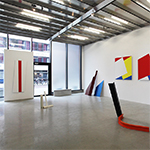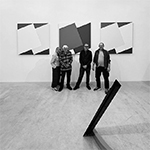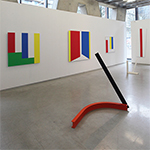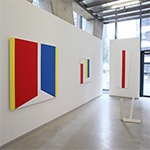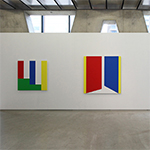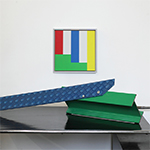Bob Bonies
Piet Tuytel
March 17 - May 19, 2024
opening Sunday 17 March, 16.00 hrs
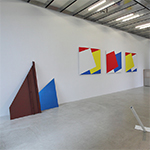
Piet Tuytel
It's all about balance. In every image Piet Tuytel (b. Alblasserdam, 1956) searches for the balance to stay on his feet. His sculptures are the buttresses of his existence. They are made of steel and are immovable in a position that is grounded. You can't get them out of place, although they always give the impression that they could fall on top of you. You must approach them with caution. If you go straight at it, you will be taken down with an outward cut. When he works on his sculptures, Piet Tuytel takes extremely heavy elements in a clasp and lifts them from his legs to move them and bring them into proportion with each other. His knees are no longer worth anything, but he still masters the martial art of making images in his head. His sculptures are trestles, wedges and plinths. They are struts and they form contrasts in hard colors. From the H and T beam he has created an alphabet of images. It is a steel script, a cuneiform script of our time. It sounds something together: weight and weightlessness, mass and void, matter and space, body and soul. His work is as concrete as poetry can be. The images suspend thinking and merge meanings. They form a unity in opposites. With Tuytel, however, the whole is never more than the sum of its parts: they fit together perfectly and when you least expect it, they kick you down. They are images like sweeping legs. After all the lashing and pulling, they elegantly lay you on their back: ippon. Piet Tuytel's sculptures make a point.
Alex de Vries
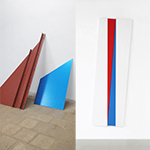
Bob Bonies
Open and welcoming, Bonies’ bright colour forms invite wonder and questions about meaning and intention. But there is no hidden message. This is about inevitable visual perception. A purely visual experience. Strict but also liberating.
Since the early 1960s, Bonies (b. The Hague, 1937) has worked exclusively with geometric shapes and the primary colours red, yellow, blue, plus green and white if required. These colour elements emerge according to a mathematical system, and he then arranges them. Colour and form and the space between are, for Bonies, the building blocks for constructions that speak for themselves and are also in a relationship with the surrounding space. In his oeuvre, now spanning some sixty years, form and colour have been completely liberated from any servitude to descriptive depiction or allusion: Concrete Art, it is what you see. Or is there more to it?
He is not alone in his colour choices and geometry as a visual language, as shown by the exhibition vormen van de kleur at the Stedelijk Museum in Amsterdam (19 November 1966–15 January 1967). Colour systematics, Hard Edge, Colorfield Painting and Minimal Art were exhibited in paintings and sculptures from England, Germany, France, the Netherlands, the USA and Switzerland. Including work by Bonies.
Bonies has always chosen maximum reduction, the art of omission. In that apparent simplicity, a surprising new image is created every time. Goethe’s famous line In der Beschränkung zeigt sich erst der Meister (It is within limitation that the master reveals himself) is perfectly applicable to Bonies’ work, as is the line that follows: Und das Gesetz nur kann uns Freiheit geben (And law alone can give us freedom). He determines for himself the order that sets him free.
The Gestalt of his work can be seen at a glance, an open invitation, but the underlying geometric system makes the mind seek constructively for the origin of the shapes in the surrounding space. A purely visual experience.
You see what you see, and yet there is more.
Jetteke Bolten-Rempt
